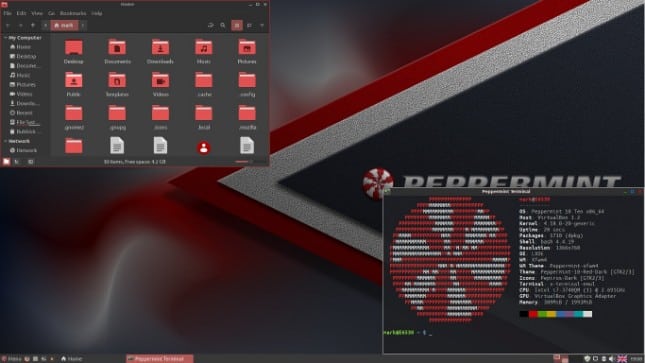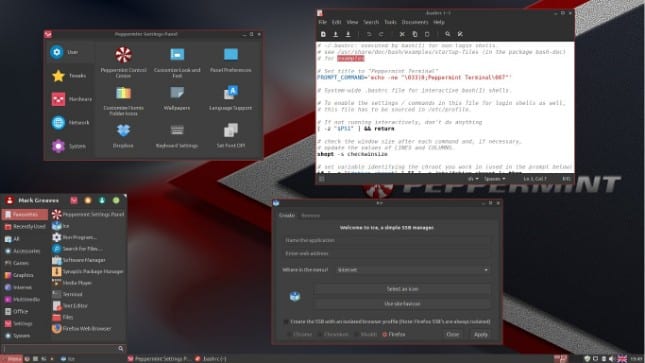Peppermint 10 Ubuntu-based Linux distribution available for download

Ubuntu is a great operating system; that's why so many other Linux distributions are based on it. Hell, even Microsoft seems to be enamored with Ubuntu these days. What makes Ubuntu so good? The Linux distro is rock solid, has tons of compatible packages, and its online community can be very helpful (unlike snooty Arch users).
Today, a lesser-known (but very good) Ubuntu-based operating system reaches a new milestone. Called "Peppermint," version 10 is now available. Peppermint 10 should be particularly good for those with modest hardware, thanks to its use of the fairly lightweight Xfce desktop environment and available 32-bit variant. With that said, those with more powerful computers should have a positive experience with Peppermint 10 too.
ALSO READ: Dell Precision 3540 and 3541 'Developer Edition' mobile workstations come with Ubuntu Linux
"Team Peppermint are pleased to announce Peppermint 10 (20190514), the latest iteration of our operating system. Based on the 18.04 LTS (long term support) code base, Peppermint 10 still comes in both 64bit and 32bit flavors so older hardware is still supported. We hope you enjoy using it half as much as we did putting it together," says Mark Greaves, Developer, Team Peppermint.
ALSO READ: Ubuntu Linux 19.04 'Disco Dingo' is finally available for download
Greaves further say, "As with previous releases we invite you to compare Peppermint to other operating systems, we are confident you will be impressed. To take the Peppermint 10 out for a test drive, please visit our website at peppermintos.com where you can download it for free. If you need help installing the Peppermint 10, or have any questions about using it, we have a second-to-none user support team at forum.peppermintos.com please drop in even if only for a chat with friendly like-minded people... hope to see you there."

Team Peppermint shares a list of changes below.
Peppermint 10 main changes
- Kernel 4.18.0-18 which is now on the rolling hwe-18.04 track so will eventually roll onto the 5.xx kernel automatically as the HWE is updated upstream.
- Updated xorg stack, again via the rolling hwe-18.04 track.
- Proprietary nvidia graphics drivers now installed automatically if “Install third party drivers/software” is selected as part of the installation routine, this includes automatic configuration of nvidia optimus setups up to the nvidia-390 drivers. If you intend to install the later 396/410/415/418/430 drivers from the ‘Proprietary GPU Drivers’ PPA it would probably be best not to select this option during install and add them manually post-install.
- Ice (6.0.2) – Ice now has support for isolated profiles for Chromium, Chrome, and Vivaldi SSB’s (Firefox SSB’s are ALWAYS isolated).Firefox SSB’s now also have four bookmarks included by default making the addition of addons and other configuration changes on a per-SSB basis easier. There are also other ‘under the hood’ changes, such as ICE will now rebuild your SSB profiles should you accidentally delete their directories. Also a bug that was stopping Ctrl+Tab hidden tab navigation has been fixed, as has a bug that made it difficult to install addons in Firefox SSB’s because the “Allow” dialog flickered.
- New GUI Font DPI Settings utility allowing adjustments to system font DPI (this also fixes a bug where the proprietary nvidia drivers sometimes displayed small fonts on the panel/menu in previous version).
Updated applications
- All 18.04 updates to 14th May 2019 have been rolled into the ISO, and we also have updated versions of:
- nemo (4.0.6) – which not only feels considerably faster at opening and rendering directory contents, but has finer
- grained control of desktop configuration options when you right-click the desktop and select ‘Customise’ .. ALL
- nemo plugins in the repository have been updated, though not all are installed by default).
- mintinstall (7.9.7)
- mintstick (1.39)
- neofetch (6.0.1)
- xed (2.0.2)
- xplayer (2.0.2)
- xviewer (2.0.2)
Other changes and additions
- xreader (replaces evince).
- light-locker & light-locker-settings (replaces i3lock, but users that prefer i3lock can easily change it back .. just uninstall those 2 packages and the system will automatically fall back to i3lock).
- network-manager-pptp-gnome (now installed by default).
- network-manager-openvpn-gnome (now installed by default).
- New ‘Peppermint-10’ xfce-panel-switch profile (for resetting the panel).
- New Peppermint 10 Gtk themes (multiple color variations).
- New default xfwm4 theme to match the new Gtk themes (the new Gtk themes also have their own individual xfwm4 themes, selectable in the Peppermint Control Center).
- The firefox-theme-lock & thunderbird-theme-lock tweaks now use the new Peppermint-10-Red-Mixed Gtk theme. These can still be disabled in the settings panel if you want Firefox and Thunderbird (should you install it) to use the system Gtk theme.
- Two new Peppermint 10 wallpapers by Karl Schneider (default and alternative).
- Four additional Ray Bilcliff wallpapers.
- New plymouth startup/shutdown screen.
- New login/lock screen background image (also by Karl Schneider).

If you want to download and install Peppermint 10, you can grab the 64-bit ISO here. And yeah, as stated earlier, a 32-bit version is available too -- it can be had here. Despite the extensive list of changes listed above, I recommend reading the official release notes here as well.
Photo credit: indira's work /Shutterstock
